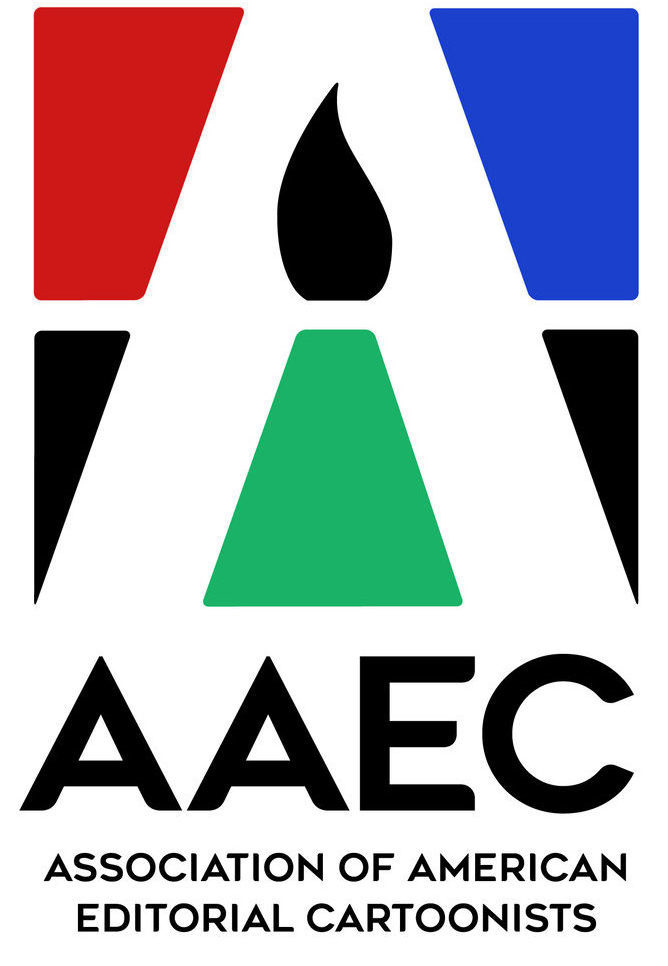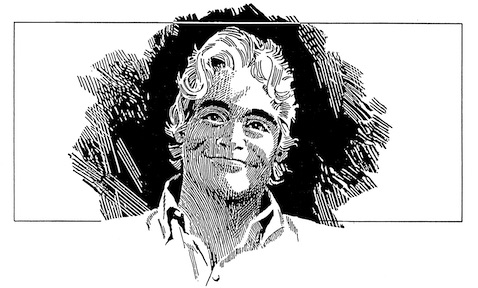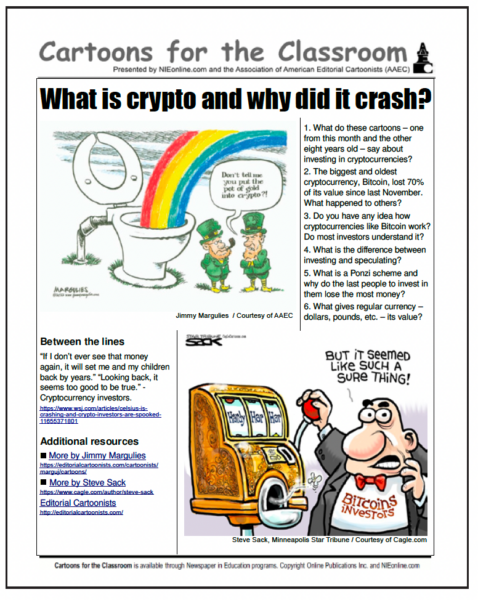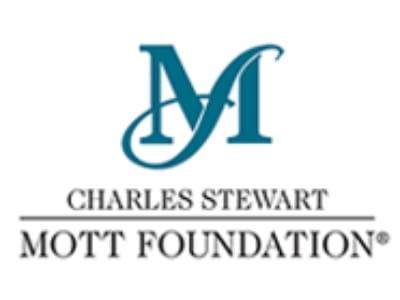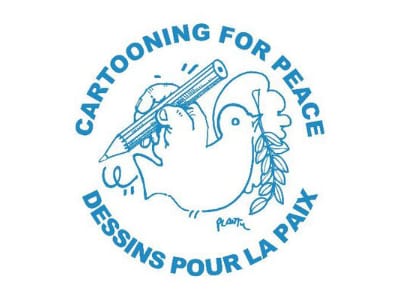Draper Hill,
the long-time Detroit News cartoonist and eminent cartoon historian, passed
away on May 13. In addition to his decades of work as a staff cartoonist,
he published biographies of Thomas Nast and James Gillray, and was long
considered the “institutional memory” of the AAEC.
“He wanted
to increase the awareness of people and get them more engaged with what’s
around them,” said his son, Jon. “He wanted to challenge them to get more
involved and interested in the political landscape. He wanted to push the
envelope.”
Other survivors
include his wife, Sarah; a daughter, Jennifer; two grandchildren, Jack
Hill and Charlie Hill; and two brothers, Jack and Peter.
Born July
1, 1935, in Boston, Draper Hill was raised in Wellesley Hills, Mass., and
graduated from Harvard University in 1957, where he was on the staff of
the Harvard Lampoon for several years.
“When still
an undergraduate at Harvard,” wrote fellow cartoonist and historian R.C.
Harvey, “Draper invited himself, unannounced, to visit Rockwell in his
studio. Rockwell was sufficiently impressed by his surprise visitor that
he gave Draper a pair of his sketches.”
He later
studied art at the Slade School of Fine Art, University College London,
on a Fulbright grant.
Hill began
his career as a cartoonist at the Patriot Ledger and Worcester Telegram
in Massachusetts and worked at the Commercial Appeal in Memphis, Tenn.,
before joining The News in 1976.
Some of
his most striking pieces skewered political figures and situations, including
Detroit’s provocative mayor, Coleman A. Young. “His cartoons were usually
a gentle form of humor, but he could draw blood when he felt it was warranted,” said
Jeffrey Hadden, Detroit News deputy editorial page editor. “As an editorial
writer, I sometimes envied his ability to more strongly convey a point
with a few well-placed pen strokes.”
As former
Detroit News Editorial Page Editor Tom Bray notes, he expertly captured
the late mayor in his cartoons. His caricature of Young as a “grinning
Cheshire cat was apt without being mean.”
The drawings
were “extremely sophisticated and had deeper meaning, so you would have
to study it,” said Ben Burns, former Detroit News executive editor and
director of the Wayne State University journalism program. “He was capable
of taking a famous piece of art and converting that into a cartoon about
something going on locally. He stimulated people to think.”
In an introduction
to an exhibition in the 1970s, Hill offered: “We are still the Peeping
Toms at the palace keyhole; still expected every now and again to hit (responsibly,
of course) just a wee bit below the belt.”
He was also
a well-known figure in Metro Detroit, deeply involved in its cultural institutions.
As Bray notes, “He cared about Detroit. He defended it from its detractors
while chastening it through his cartoons.”
In 1983,
he earned a Guggenheim Fellowship to work on a biography of political cartoonist
Thomas Nast. His previous works included “Mr. Gillray, the Caricaturist,” a
biography of James Gillray.
A past president
of the Association of American Editorial Cartoonists, Hill wrote its magazine’s
history column and won Germany’s Thomas Nast Prize in 1990, said Secretary/Treasurer
V. Cullum Rogers. “He was a repository of history. Among working cartoonists
in the U.S., he probably knew more about the field than any other.”
His successor at The News, Henry
Payne, called him “one of the deans of American cartooning.” His office
was a small museum of cartooning, festooned with historical examples of
cartoons and signed originals from his colleagues.
Payne described him as an “encyclopedia
of cartoon knowledge” as well as a “talented draftsman in his own right.”
“Each of
us is unique in our own way, but Draper was without peer in his passion
for cartooning, its practice and its history,” wrote Harvey. “In his devotion,
hand and mind, to his profession, Draper successfully ignored the ordinary
distractions of everyday life. He was not, for example, attentive to his
attire: he looked, usually, as if he’d just thrown something on and missed,
somewhat—his tie notoriously askew, sometimes half over his dress shirt
collar, half under; shirt-tail untucked and extending below the bottom
edge of his jacket; hair combed in front but not in back, where a night’s
tossing and turning had produced a proudly flourishing rooster-tail. ‘Sloppy’ is
too strong a word for Draper, and ‘mussed’ implies a conscious effort;
but ‘disheveled’ is about right.
“Shopping
for vintage books in musty second-hand book stores was an obsession with
both of us, and we always devoted the convention’s free afternoon to forays
into the hinterlands of the host city, looking for used-book stores and
treasure. On a couple occasions, Draper and I went together, and you’d
think we’d be scrabbling over some rare tome on cartooning that we’d discovered
jointly and both wanted. Not so. Draper usually had them all already. ‘Here’s
something you need,’ he’d say, pointing, in this case, to John
Leech’s Pictures of Life and Character (1887)
in two volumes, reprinting Leech’s cartoons from Punch, 1842-64.
‘They’re in great shape,’ he added; ‘you really ought to have them.’”
After being forced into retirement in
1999, Mr. Hill often exhibited his work and lectured.
“He claimed
the paper’s officials never told him, explicitly, the reasons for their
actions,” wrote Harvey. “I suspect they simply wanted a younger and perhaps
less scholarly visual commentator, and, judging from the man hired to replace
Draper, a more conservative point of view.
“For a time,
Draper was without medical benefits as well as employment, a circumstance
that, after 23 years on the payroll and with the debilities of age and
illness looming, was sad to the point of tragic, tragic to the point of
criminal. His colleagues were alarmed and angry. Said Joel Pett, at the
time president of AAEC: ‘It’s a shame Draper was treated with such a lack
of dignity. He’s a really dedicated practitioner of the craft and just
about the kindest and most generous gentleman it has been my pleasure to
know in the business.’
“But after
a while, Draper was able to work out a satisfactory arrangement with the
paper that left him somewhat less than destitute …”
Kevin “Kal” Kallaugher remembered
in his affectionate salute to Draper: “One of my best memories from the
AAEC took place at a business meeting some years ago. Draper had been a
fixture at our conventions for decades. One of his unofficial duties was
to prompt the dim-witted officers on stage (including me) from his perch
in the front row on official protocol and parliamentary procedure. (A role
now happily occupied by the esteemed Cullum Rogers). Due to illness, Draper
was, at the time I’m recalling, missing his first ever AAEC convention.
The silence from his empty seat was deafening. Late in the meeting, Ben
Sargent stood to recognize our absent colleague. He made a motion asking
the AAEC to officially declare Draper Hill as ‘Present’ at that convention.
The motion passed unanimously. Draper’s streak remained unbroken. I will
miss Draper. The wonderfully brilliant warm and witty Draper. To me he
will always be ‘present’ at the AAEC conventions.”
—Sources:
The Detroit News, R.C. Harvey. JP Trostle and Cullum Rogers contributed.
For more about Draper Hill, visit RCHarvey.com, Rants & Raves, Opus
242.

